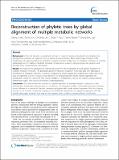| dc.contributor.author | Ma, Cheng-Yu | |
| dc.contributor.author | Lin, Shu-Hsi | |
| dc.contributor.author | Lee, Chi-Ching | |
| dc.contributor.author | Tang, Chuan Yi | |
| dc.contributor.author | Berger, Bonnie | |
| dc.contributor.author | Liao, Chung-Shou | |
| dc.date.accessioned | 2013-05-01T15:47:55Z | |
| dc.date.available | 2013-05-01T15:47:55Z | |
| dc.date.issued | 2013-01 | |
| dc.identifier.issn | 1471-2105 | |
| dc.identifier.uri | http://hdl.handle.net/1721.1/78648 | |
| dc.description.abstract | Background: In the last decade, a considerable amount of research has been devoted to investigating the phylogenetic properties of organisms from a systems-level perspective. Most studies have focused on the classification of organisms based on structural comparison and local alignment of metabolic pathways. In contrast, global alignment of multiple metabolic networks complements sequence-based phylogenetic analyses and provides more comprehensive information.
Results: We explored the phylogenetic relationships between microorganisms through global alignment of multiple metabolic networks. The proposed approach integrates sequence homology data with topological information of metabolic networks. In general, compared to recent studies, the resulting trees reflect the living style of organisms as well as classical taxa. Moreover, for phylogenetically closely related organisms, the classification results are consistent with specific metabolic characteristics, such as the light-harvesting systems, fermentation types, and sources of electrons in photosynthesis.
Conclusions: We demonstrate the usefulness of global alignment of multiple metabolic networks to infer phylogenetic relationships between species. In addition, our exhaustive analysis of microbial metabolic pathways reveals differences in metabolic features between phylogenetically closely related organisms. With the ongoing increase in the number of genomic sequences and metabolic annotations, the proposed approach will help identify phenotypic variations that may not be apparent based solely on sequence-based classification. | en_US |
| dc.description.sponsorship | National Institutes of Health (U.S.) (Grant GM081871) | en_US |
| dc.language.iso | en_US | |
| dc.publisher | Biomed Central Ltd. | en_US |
| dc.relation.isversionof | http://www.biomedcentral.com/1471-2105/14/S2/S12/abstract | en_US |
| dc.rights | Creative Commons Attribution | en_US |
| dc.rights.uri | http://creativecommons.org/licenses/by/2.0 | en_US |
| dc.source | BioMed Central | en_US |
| dc.title | Reconstruction of phyletic trees by global alignment of multiple metabolic networks | en_US |
| dc.type | Article | en_US |
| dc.identifier.citation | Ma, Cheng-Yu et al. “Reconstruction of phyletic trees by global alignment of multiple metabolic networks.” BMC Bioinformatics 14.2 (2013). | en_US |
| dc.contributor.department | Massachusetts Institute of Technology. Computer Science and Artificial Intelligence Laboratory | en_US |
| dc.contributor.department | Massachusetts Institute of Technology. Department of Mathematics | en_US |
| dc.contributor.mitauthor | Berger, Bonnie | |
| dc.relation.journal | BMC Bioinformatics | en_US |
| dc.eprint.version | Final published version | en_US |
| dc.type.uri | http://purl.org/eprint/type/JournalArticle | en_US |
| eprint.status | http://purl.org/eprint/status/PeerReviewed | en_US |
| dc.identifier.orcid | https://orcid.org/0000-0002-2724-7228 | |
| mit.license | PUBLISHER_CC | en_US |
| mit.metadata.status | Complete | |
